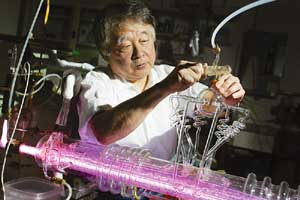Oka receives honor for spectroscopy studies in chemistry
By Steve KoppesNews Office
 Takeshi Oka |
Takeshi Oka, the Robert Millikan Distinguished Service Professor in Chemistry and the College, received the E. Bright Wilson Award in Spectroscopy at the American Chemical Society meeting earlier this month.
The Rohm and Haas Company established the award in 1994 to recognize outstanding accomplishments in fundamental or applied spectroscopy in chemistry. The ACS honored Oka for his pioneering studies of a variety of ions that are important to astrophysics, including his favorite, H3+.
“This is by far the most abundant molecular ion in the universe,” Oka said. It also is one of the most important molecules in space, he said, because it serves as a catalyst that spurs the creation of nearly all other molecules. Consisting of three bound hydrogen atoms, minus an electron, H3+ controls the chemistry of interstellar gas clouds. This chemistry, in turn, controls how fast the gas can cool and collapse to form stars.
The proton attached to H3+ is what makes it so important. When this proton interacts with another molecule, that other molecule suddenly becomes very active.
Oka has conducted his searches for interstellar molecules using the United Kingdom Infrared Telescope for 20 years and the Japanese Subaru Telescope recently, both of which are located atop Mauna Kea in Hawaii.
Scientists proposed the existence of H3+ in interstellar space in 1961. The long-sought molecule eluded detection in interstellar space, however, until Oka did it in 1996. But before he could even begin to search for the molecule in space he had to identify its spectrum, or chemical fingerprint, in the laboratory. He accomplished that task in 1980, but only with great difficulty and the assistance of a highly sensitive laser spectrometer.
The molecule is interesting because it is highly active. Most molecules do not react when they come together. But Oka likened H3+ to an agitated political revolutionary who arouses everyone around him into action. The molecule is so highly active that it survives for only a fraction of a nanosecond under atmospheric conditions on Earth. “It reacts right away with whatever it meets,” Oka said.
Extraterrestrial H3+ was first observed on Jupiter in 1987.
“Nobody was looking for it. Somebody found it accidentally,” Oka said. At first, scientists didn’t understand what it was. The laboratory work of one of Oka’s students, Moungi Bawendi (Ph.D.,’88), clarified the identity of the molecule.
“His laboratory result was essential in understanding the spectrum of H3+ on Jupiter,” Oka said. “I’m very proud of that.”
Bawendi, now a professor of chemistry at the Massachusetts Institute of Technology, said he owes a lot to Oka’s mentorship.
“He projects an enthusiasm for science, which is really contagious to the students,” Bawendi said. “I learned a lot from him. I learned how to think, which is what I’m trying to teach my graduate students now.”
Oka, likewise, said he owes a lot to a long line of students. “I’ve been very lucky to have so many excellent students.”
![[Chronicle]](/images/small-header.gif)